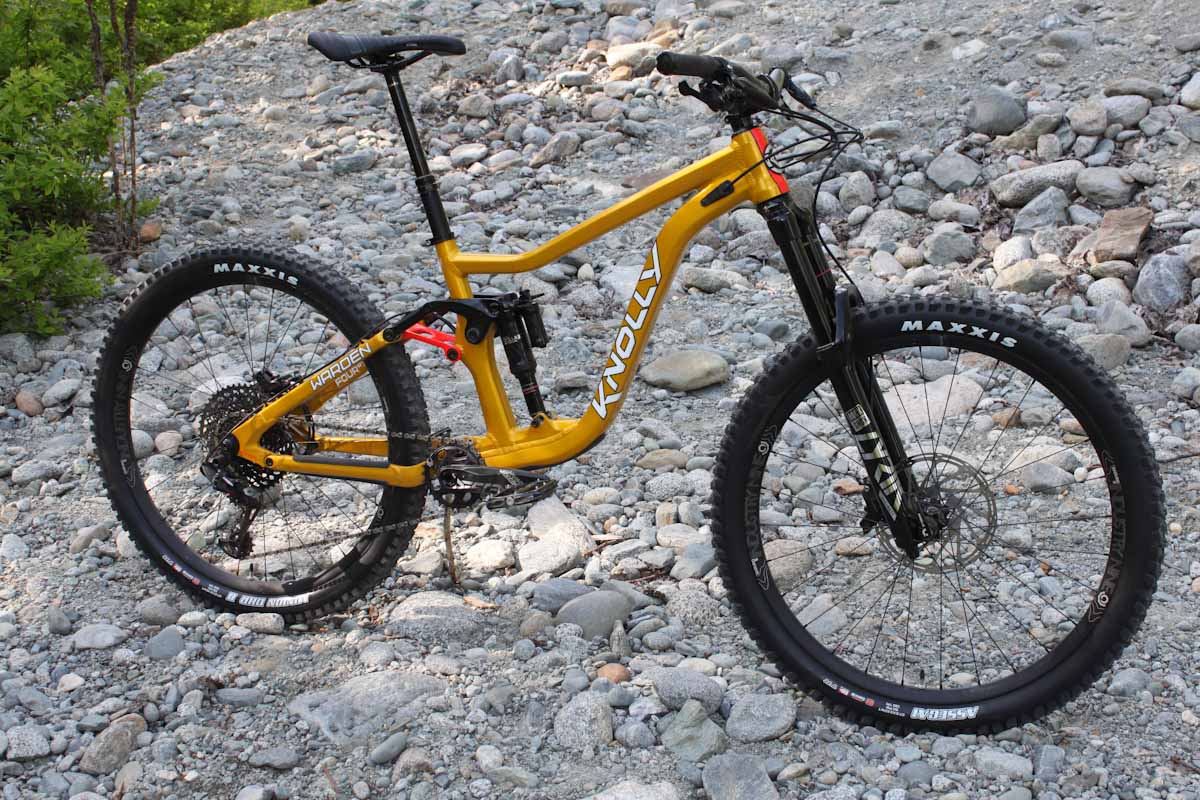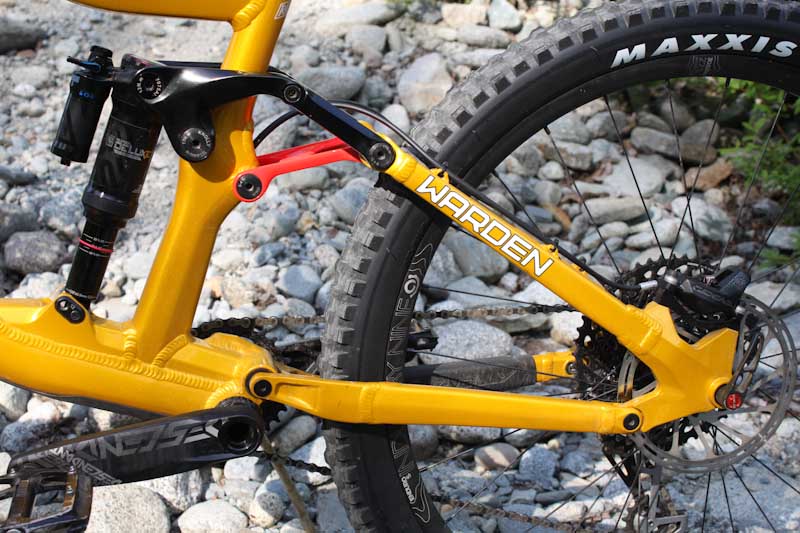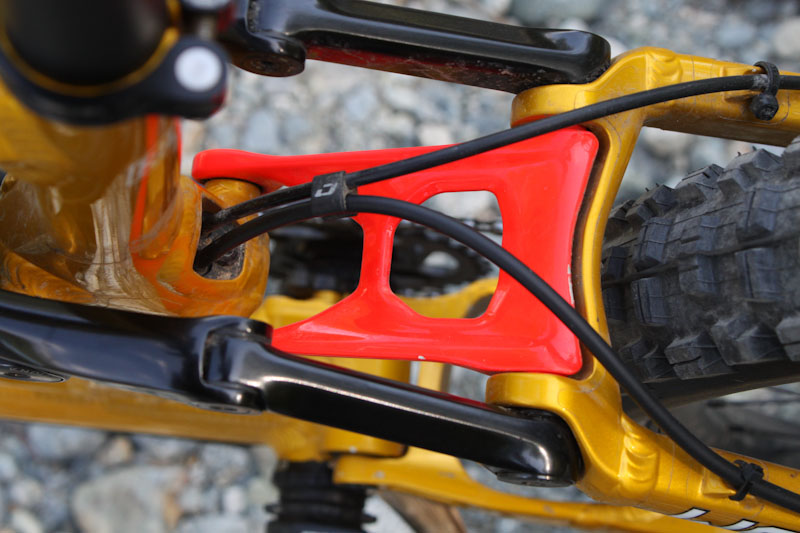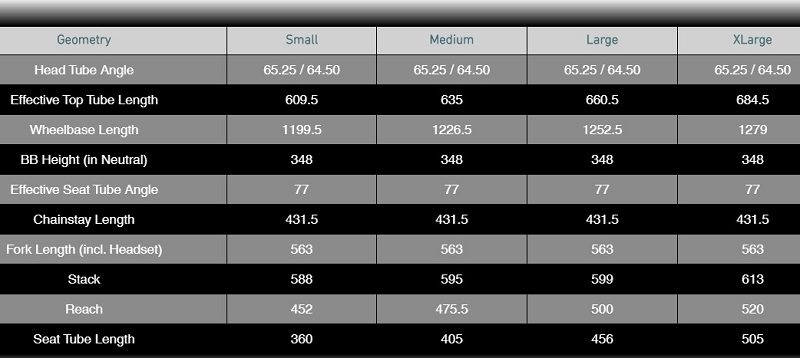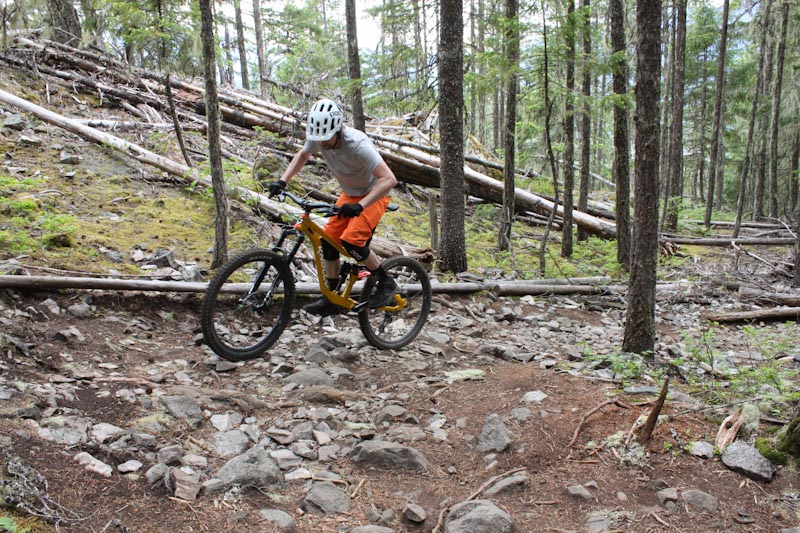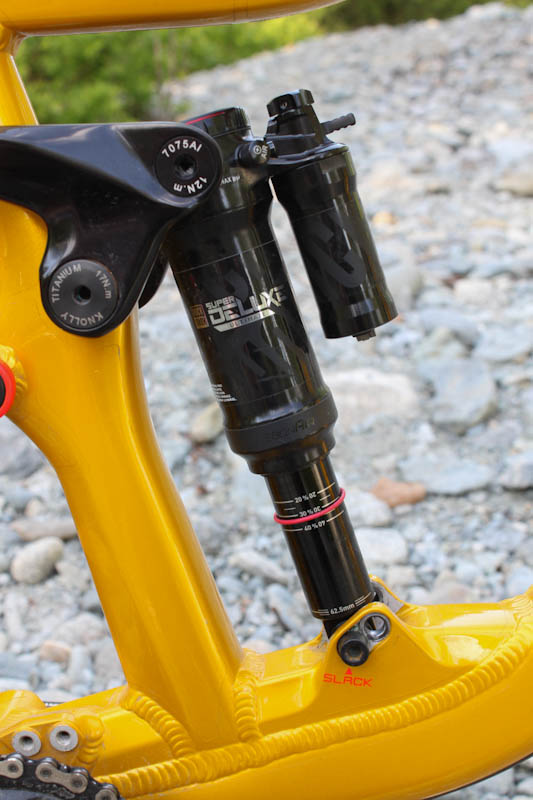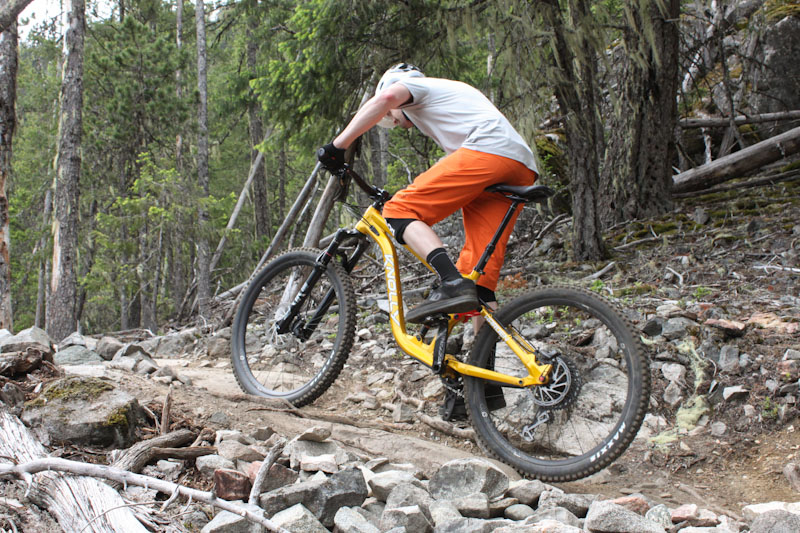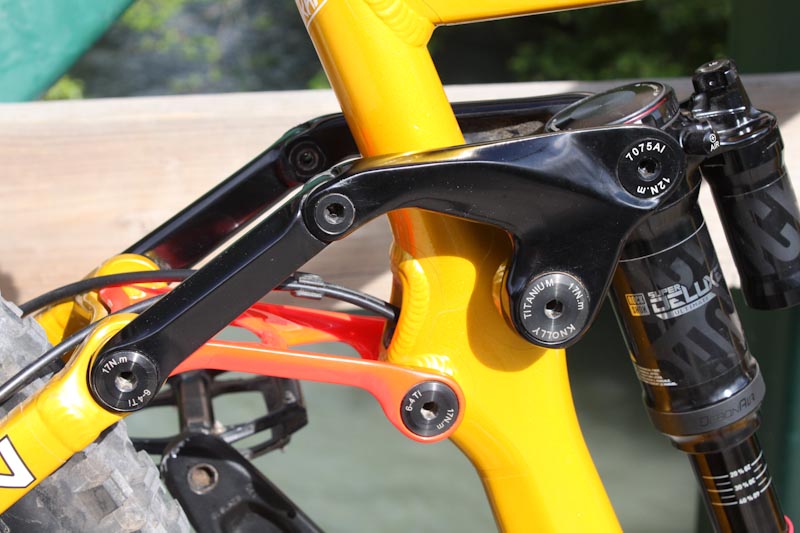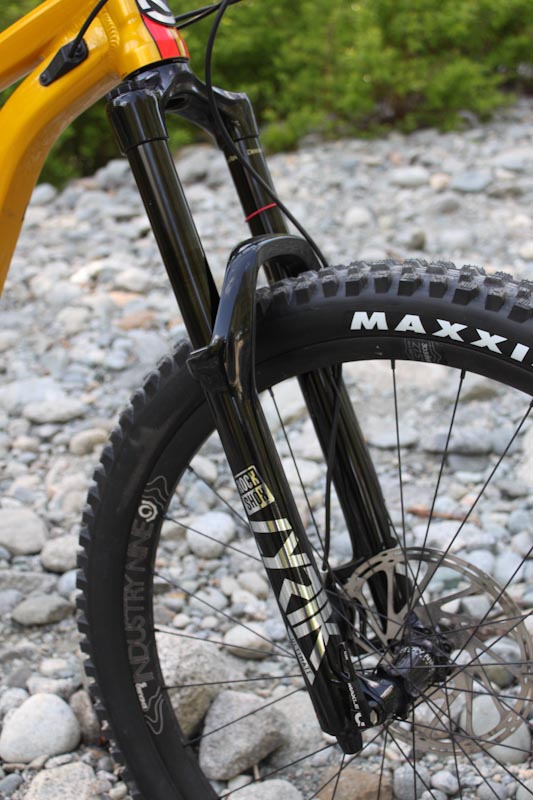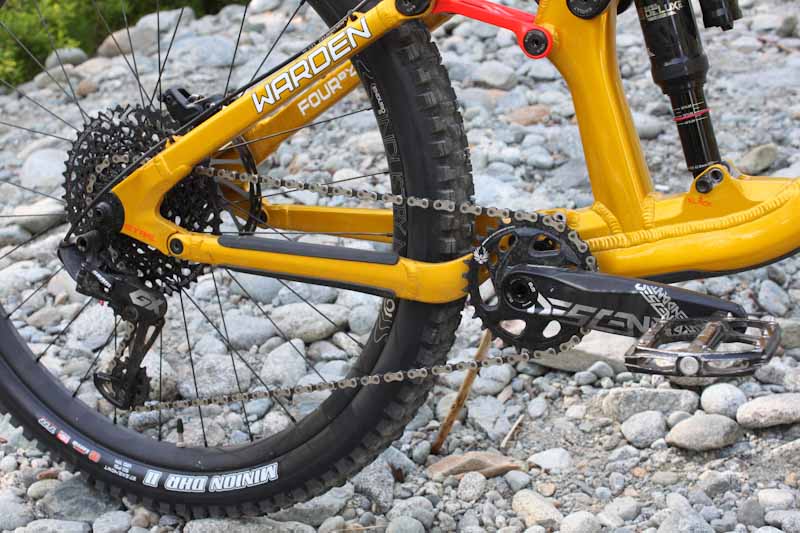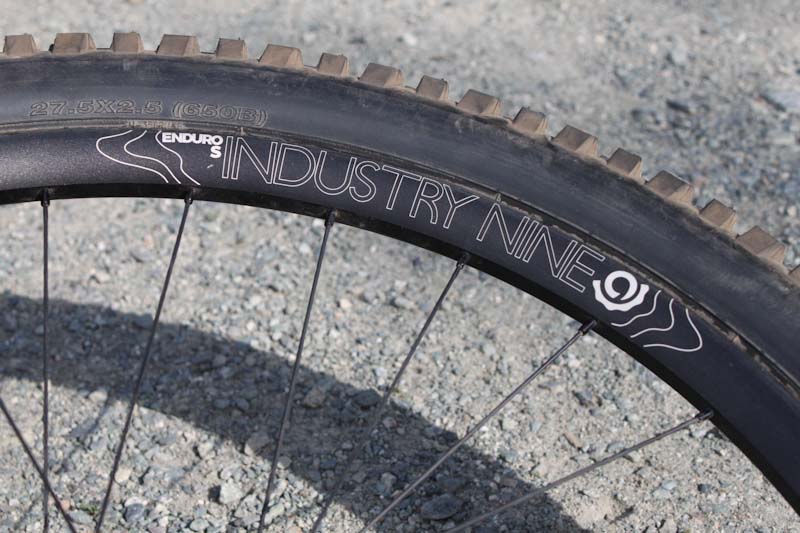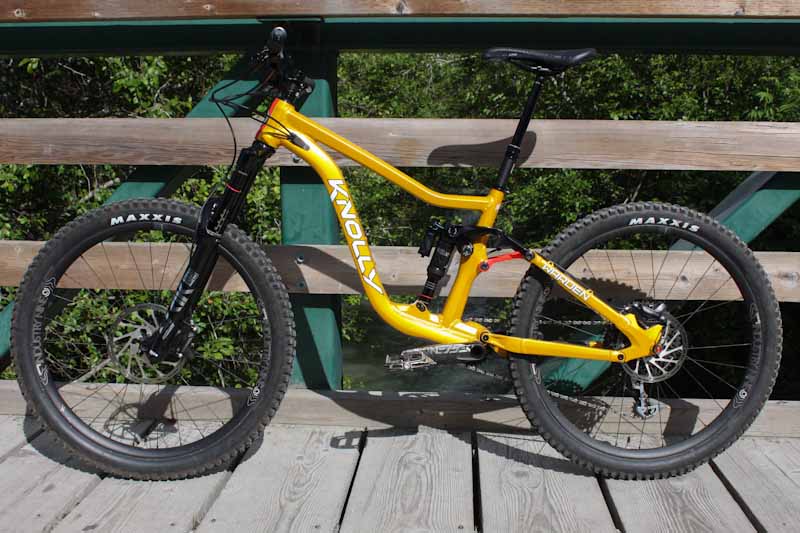With 168/170mm of travel, 27.5” wheels and aggressive frame geometry, Knolly’s Warden LT is a full-on enduro machine. This bike is oh-so comfortable and capable thrashing down rough technical trails, but Knolly’s Fourby4 linkage allows this burly looking bike to roll uphill rather efficiently too.
I got one ride on the updated Warden with Knolly’s head honcho Noel Buckley last summer, but this spring I got the chance to borrow the long travel (LT) model for a few weeks. While the Warden LT is impressively soft and supple when you’re charging through rough stuff, Knolly has retained an overall playful ride and the bike still climbs well, pops off jumps and doesn’t numb away all the feeling from the trail below.
Knolly Warden LT frame specs:
The Warden LT features a 6066 hydroformed aluminum frame with 168mm of rear travel, and they’re set up with 170mm forks. All that rear travel is controlled by Knolly’s Fourby4 linkage; the frame relies on the lower link to dictate wheel path, while the upper link controls the shock rate. The chainstay link keeps the suspension active under braking. The Warden LT offers Neutral and Slack shock mounting positions, and I’ll explain how they alter the bike’s handling in my ride impressions below.

Not long ago, Knolly started switching their bikes to Trail 157 (157mm width) rear ends. The wider spacing enables shorter rear stays with plenty of tire clearance (up to 27.5×2.8” treads on the Warden LT). The wider rear end also allows for stronger rear wheels, as the spokes can be pushed outwards on the hub for better bracing. Despite the wider axle, Knolly has managed to keep their rear stays narrower than some Boost 148mm bikes.
Knolly designs their frames with full length, straight seat masts to accommodate long travel dropper posts. The Warden LT accepts 31.6mm diameters, and you won’t have trouble getting a long enough post in it. My Medium demo bike came with a 175mm RockShox Reverb.

Cable routing is internal through the front triangle and exits at the back of the seat mast. The frame plugs pinch the cables so they don’t rattle while you ride, and they’ll fit 4mm, 5mm or Di2 housings. There’s also a Di2 battery compartment behind the down tube protector in case you want to go electric.
Other fitments and features include a threaded BB with a removable ISCG05 mount and an e-type derailleur/upper chain guide mount. Knolly’s pivots are built around titanium hardware and a mix of dual-row angular bearings and IGUS bushings, and there is one water bottle mount on the Warden LT’s down tube.
The Warden LT I was riding features the Dawn Patrol build, with one extra; an optional Industry Nine Enduro S wheelset. The base Dawn Patrol bike comes with Spank Oozy Trail 345 wheels, but buyers can upgrade to Industry Nine’s Enduro S or Enduro S Hydra wheelsets for a few extra bucks.
The Warden LT Dawn Patrol with the Industry Nine Enduro S wheel upgrade weighs in at 33.44 lbs (including pedals).
Geo and Fit:
Most of the numbers on the Warden LT are fairly normal for today’s enduro bikes, but Knolly is definitely pushing the envelope on front end length. With an effective top tube length of 635mm and a 475.5mm reach, the Warden LT is by far the longest Medium frame I’ve ridden. A stack height of 595mm keeps the Warden’s front end low, so riders who like an aggressive stance can achieve it.
The geo chart above doesn’t show all this info, but switching the rear shock from Neutral to Slack mode slackens the head tube and seat tube angles by .75°, lowers the BB about 12mm, reduces the reach by a few millimetres, and makes the shock rate more progressive.
Ride Impressions: Climbing
In Neutral position, the Warden LT’s steep seat mast puts the rider in a powerful pedalling position, and the low, lengthy front end ensures your body weight stays balanced between the wheels; You definitely won’t feel like you’re ‘in the back seat’ on this bike. I was surprised how easily I adapted to a frame that’s 35mm longer in reach than my personal ride. It was apparent that my arms were straighter on the Warden LT, but not dangerously so… that said, at 5’9” I don’t think I could ride anything longer up front than this bike.
The Warden LT’s front end is long enough that when seated, on really steep pitches I started to notice how far out the front wheel sits. However, when that front wheel started to feel light I had no problem standing up and shifting my weight up over that lengthy front end.
While it quickly softens up under impacts, the Warden’s rear end remains supportive while you’re pedalling along. With the RockShox Super Deluxe Ultimate RCT rear shock in climb mode (and in Neutral position) the Warden LT will use about 50-55% travel on technical, bumpy climbs. The linkage allows enough wheel movement to track very well over rocks and roots, while the shock’s climb mode reduces pedal bob to ensure your efforts are moving you forward. It’s also handy that the Super Deluxe Ultimate RCT offers a low speed compression adjustment, which can help fine-tune the bike’s softness while climbing.
With the shock wide open, the LT still won’t dip much deeper into its travel from pedalling forces alone. While you can see the shock bobbing slightly with each pedal stroke, the rear end still stopped at about 55% travel on smooth terrain. When you ride bumpy trails in open mode, the shock will allow for more movement and hit 60-70% travel. The rear end also feels noticeably softer in this mode compared to climb, and sucks up bumps with no hesitation. This extra wheel movement offers superb traction on highly technical climbs with a minimal sacrifice in pedalling efficiency.
Halfway through my test I switched the Warden LT into its Slack position, and was pleased to find it had hardly any impact on the bike’s climbing capabilities. The seat mast is still very steep at 76.25°, and I only noticed a marginal rearward shift in body position when tackling the steepest climbs. The steering angle in Slack position is 64.5° but I don’t find that slack enough to make climbing awkward, even in tight switchbacks.

Right away I noticed the slightly reduced reach in Slack position. I was comfortable riding the LT in Neutral, but I felt more at home when the bike’s reach was slightly reduced and I got a bit more bend in my elbows. I could also feel that the BB had dropped, yet I only clipped one pedal on a root during all my test rides.
Between the Neutral and Slack positions, there’s not much difference in how the shock acts or feels while climbing singletrack; I was using the same amount of travel in either setting, as the Slack position’s added progressivity doesn’t really present itself until you start thrashing downhill.
While we’re talking about pedalling, I should note I’ve had no issues with heel clearance on the Trail 157 rear end throughout my testing.
Descending:
On my first descent the Warden LT’s generous travel (18mm’s more than my personal bike) was apparent. In Neutral position, it wasn’t hard to get full compression from the rear end – There is enough ramp-up to prevent you from blowing through your travel too easily, but I had no trouble bottoming out the bike during a rough ride. Right away I was impressed with the Warden LT’s sensitive, supple impact absorbing qualities.
The LT’s long 1226.5mm wheelbase gives this bike a very, very stable ride at high speeds, and while it is more pronounced in Slack it’s already a solid ride in Neutral. While the front end is long, the LT’s rear triangle is fairly short so lifting the front wheel is no problem.
After switching to Slack mode, I found the difference in body position and steering angle is much more noticeable on the descents versus the climbs. While it’s not a huge shift from Neutral, moving to Slack makes it easier to hang over the rear wheel when you’re diving down a steep chute, and the steering feels even more stable.
The rear shock definitely ramps up more with the bike in Slack position – after making the switch, I had to hit the LT pretty hard to use all its travel. Given more time with the bike, I would have pulled a volume spacer from the rear shock (it had two inside) which I suspect would dial things in perfectly for me.
Excellent traction is something Knolly strives to achieve, and I think they’ve done a fine job of that. The Warden LT’s lively rear end sticks to every kind of terrain well, whether rough slabs, chattery high-speed sections, or root gardens. Larger, sharper hits are quickly absorbed but on moderately bumpy sections the ride isn’t so soft that you lose all the feedback from the trail.
While the Warden LT provides a cushy ride in chunky terrain, Knolly has maintained good support from their linkage as well. This isn’t just a bike that gobbles up rough trails with ease, it’s a well-rounded ride that also pedals well, pops nicely off jumps and springs out of corners.
The front end of the Warden LT feels stiff and solid as you plow through rock gardens, and the Trail 157 rear end keeps things stiff out back too. I can’t say I notice a significant leap in frame or rear wheel stiffness from the widened rear end vs. Boost-spaced bikes, but I believe the science behind it and I’m not clipping my heels.
What I concluded from my test rides (and is opposite to Knolly’s Fugitive LT I tested last summer) is the Warden LT is a bike I’d keep in Slack position most often. This position maxes out the bike’s fun and impressive downhill capabilities with practically no penalty to pay on the climbs.
Components:
RockShox’s 170mm Lyrik Ultimate RC2 fork offered butter-smooth operation, and after pulling the token from it I had no problem getting full travel with my 145lbs. weight. As a lighter guy, I’ve never found any recent Lyriks lacking in stiffness. Out back, the climb setting on the Super Deluxe Ultimate RCT shock was great, making my pedal strokes feel much rounder and more efficient with a flip of the switch.
SRAM’s GX drivetrain performed without fault, and the Code R brakes on 200/180mm rotors were almost flawless – I did nearly overheat them on one fast, unfamiliar descent but they were more than ample for every other ride. I had no issues with the RockShox Reverb Stealth 175mm dropper post, and I love how easily the newer models drop.
The Industry Nine Enduro S wheels provided a pretty stiff ride, and the Maxxis Assegai/Minion DHR 3C EXO tires are a proven combo. Lastly, Knolly has teamed up with Whistler, B.C.’s Chromag for some high quality OEM components including their Lynx DT saddle, OSX 35x800mm handlebars, Basis grips and 50mm Hifi stems.
Wear and tear:
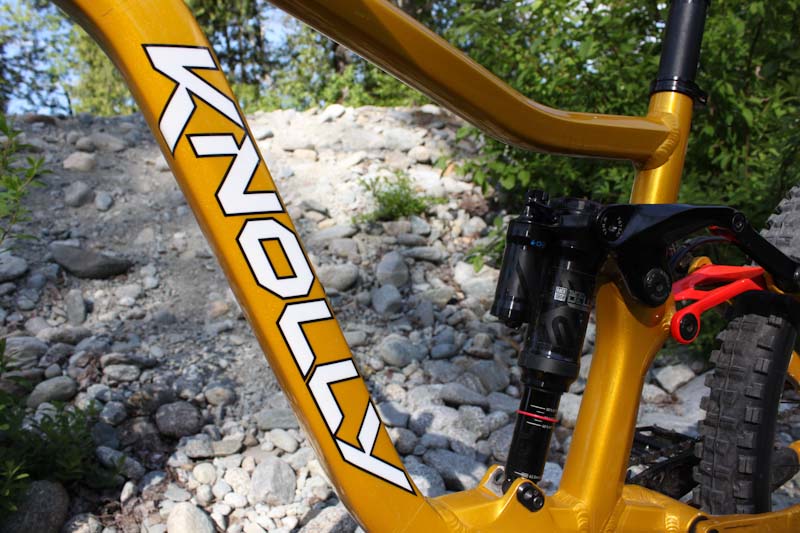
There isn’t much to report in terms of wear or damage, but here’s how the Warden LT held up through its testing: The worst thing I did was blow out one spoke on the Enduro S rear wheel, which didn’t seem to follow a nasty impact. My riding buddy did mention there was a stick hanging out in a corner we just passed, so I may have simply torn out the spoke. The rim only went slightly out of true from that incident but both rims are showing some deep scratches through their black finish, likely from bouncing rocks.
Knolly Ride Wrapped the Warden LT before I got it, but the chain took some chips out of the nice gold paint job on the inside of the seatstay – right in the tiny gap between the wrap pieces! Owners might want to protect this area of the frame carefully. Aside from this, there’s nothing else of concern to report on the Warden LT’s frame or components.
The Warden LT Dawn Patrol retails for $4700 but the Industry Nine Enduro S wheel upgrade I rode adds and extra $150. They are available through Knolly dealers or online. Frame color options are gold, black or raw, and sizes range from S-XL.
